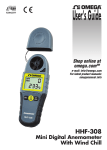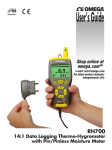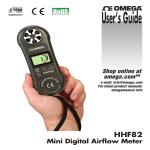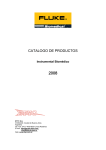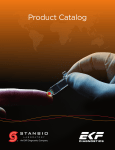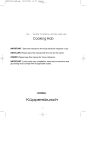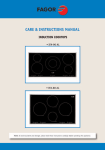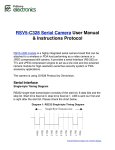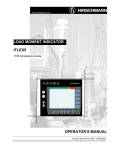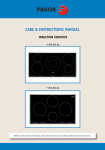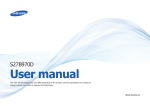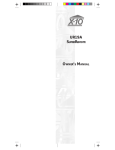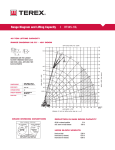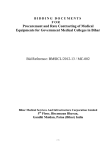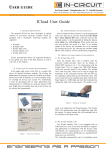Download Manuals - OMEGA Engineering
Transcript
User’s Guide Shop online at omega.com SM e-mail: [email protected] For latest product manuals: omegamanual.info HHAQ-108 Formaldehyde Meter omega.com [email protected] U.S.A.: Servicing North America: Omega Engineering, Inc., One Omega Drive, P.O. Box 4047 Stamford, CT 06907-0047 USA Toll-Free: 1-800-826-6342 (USA & Canada only) Customer Service: 1-800-622-2378 (USA & Canada only) Engineering Service: 1-800-872-9436 (USA & Canada only) Tel: (203) 359-1660 Fax: (203) 359-7700 e-mail: [email protected] For Other Locations Visit omega.com/worldwide The information contained in this document is believed to be correct, but OMEGA accepts no liability for any errors it contains, and reserves the right to alter specifications without notice. FORMALDEHYDE METER USER’S MANUAL HHAQ-108 Please read this manual carefully and thoroughly before using this product TABLE OF CONTENTS Key Features .................................................................... 7 What’s in thePackage ...................................................... 8 Product Overview ........................................................ 8-9 Setup Instructions ..................................................... 9-10 Install Batteries ................................................ 9-10 Operating Instructions ............................................. 10-14 Specifications .......................................................... 14-15 Operating and Maintenance Tips ............................. 15-18 INTRODUCTION Thank you for purchasing OMEGA’s HHAQ-108 Formaldehyde Meter. Please read this user’s manual carefully and thoroughly before using the product. The HHAQ-108 is an easy-to-use handheld instrument for measuring levels of gaseous formaldehyde (HCHO) as part of a workplace indoor air quality (IAQ) maintenance program or to spot-check a residential environment. Exposure to formaldehyde has a significant impact on human health. In 2011, the U.S. National Toxicology Program described formaldehyde as “known to be a human carcinogen.” It can also be toxic and allergenic. 2 Formaldehyde—which is colorless and has a characteristic pungent, irritating odor—is ubiquitous. It is produced by the oxidation or combustion of methane and other carbon compounds and is therefore present in forest fires, automobile exhaust, and tobacco smoke. When produced in the atmosphere by the action of sunlight and oxygen on atmospheric methane and other hydrocarbons, formaldehyde becomes part of smog. The primary exposure concern is for the workers in the industries producing or using formaldehyde. Including indirect employment, over 4 million people work in the formaldehyde industry across approximately 11,900 plants in the U.S. and Canada alone. For example, the textile industry uses formaldehyde-based resins as finishers to make fabrics crease-resistant. Formaldehyde-based materials are key to the manufacture of automobile transmissions, electrical systems, engine blocks, door panels, axles and brake shoes. Occupational exposure to formaldehyde by inhalation is mainly from three types of sources: thermal or chemical decomposition of formaldehyde-based resins, formaldehyde emission from aqueous solutions (for example, embalming fluids), and combustion of a variety of organic compounds. Because formaldehyde resins are used in many construction materials it is one of the more common indoor air pollutants. At concentrations above 0.1 ppm in air, formaldehyde can irritate the eyes and mucous membranes, resulting in watery eyes. Formaldehyde inhaled at this concentration may cause headaches, a burning sensation in the throat and difficulty breathing, and can trigger or aggravate asthma symptoms. When treated with phenol, urea, or melamine, formaldehyde produces polymer resins that are commonly used as permanent adhesives in plywood and carpeting, in nail 3 hardeners and nail polish, and as the wet-strength material added to sanitary paper products such as facial tissue, table napkins and roll towels. Production of formaldehyde resins accounts for more than half of formaldehyde consumption. Other formaldehyde derivatives include methylene diphenyl diisocyanate, an important ingredient of polyurethane paints and foams. Formaldehyde has been found as a contaminant in several bath products, at levels from 54 to 610 ppm; it is thought to arise from the breakdown of preservatives in the products. Since 2006, formaldehyde (methylene glycol) is also used in hair smoothing treatments in order to straighten wavy/curly hair and make hair less prone to frizz in humid weather. OSHA Oregon has reported these treatments as unsafe for human health. An aqueous solution of formaldehyde can be useful as a disinfectant as it kills most bacteria and fungi, including their spores. Formaldehyde solutions are applied topically in medicine to dry the skin, such as in the treatment of warts. Urinary tract infections are often treated with a derivative of formaldehyde (methenamine), a method often chosen because it prevents overuse of antibiotics and the resultant development of bacterial resistance to them. Some topical creams, cosmetics and personal hygiene products contain derivatives of formaldehyde as the active ingredients that prevent the growth of potentially harmful bacteria. A 1988 Canadian study of houses with urea-formaldehyde foam insulation found that formaldehyde levels as low as 0.046 ppm were positively correlated with eye and nasal irritation. A recent review of studies has shown a strong association between exposure to formaldehyde and the development of childhood asthma. Chronic exposure at higher 4 levels, starting at around 1.9 ppm, has been shown to result in significant damage to pulmonary function, resulting in reduced maximum mid-expiratory flow and forced vital capacity. There is also research that supports the theory that formaldehyde exposure contributes to reproductive problems in women. RESIDENTIAL EXPOSURE In the residential environment, formaldehyde exposure comes from a number of different routes; formaldehyde can off-gas from wood products, such as plywood or particle board, but it is produced by paints, varnishes, floor finishes, and cigarette smoke as well. The U.S. Environmental Protection Agency (EPA) allows no more than 0.016 ppm formaldehyde in the air in new buildings constructed for that agency. An EPA study found that a new home measured 0.076 ppm when brand new and 0.045 ppm after 30 days. The agency recommends the use of “exterior-grade” pressed-wood products with phenol instead of urea resin to limit formaldehyde exposure, since pressedwood products containing formaldehyde resins are often a significant source of formaldehyde in homes. People who suffer allergic reactions to formaldehyde tend to display lesions on the skin in the areas that have had direct contact with the substance, such as the neck or thighs (often due to formaldehyde released from permanent-press clothing) or dermatitis on the face (typically from cosmetics). Formaldehyde has been banned in cosmetics in both Sweden and Japan. The eyes are most sensitive to formaldehyde exposure: The lowest level at which many people can begin to smell formaldehyde is about 0.05 ppm and the highest level is 1 ppm. The maximum concentration value at the workplace is 5 0.3 ppm. In controlled chamber studies, individuals begin to sense eye irritation at about 0.5 ppm; 5 to 20% report eye irritation at 0.5 to 1 ppm; and greater certainty for sensory irritation occurred at 1 ppm and above. While some agencies have used a level as low as 0.1 ppm as a threshold for irritation, the expert panel found that a level of 0.3 ppm would protect against nearly all irritation. In fact, the expert panel found that a level of 1.0 ppm would avoid eye irritation—the most sensitive endpoint—in 75 to 95% of all people exposed. Formaldehyde emits from a variety of construction materials, furnishings, and consumer products. The three products that emit the highest concentrations are medium-density fiberboard, hardwood plywood, and particle board. Environmental factors such as temperature and relative humidity can elevate levels because formaldehyde has a high vapor pressure. Formaldehyde levels from building materials are the highest when a building first opens because materials have had less time to off-gas. Formaldehyde levels decrease over time as the sources suppress. A Guide to Formaldehyde Exposure Levels 0.03 ppm 0.10 ppm 0.40 ppm 0.50 ppm 6 Average outdoor level Recommend upper short-term exposure limit (STEL) limit for residences by ASHRAE, ANSI, EPA, and NIOSH Recommended upper STEL for manufactured homes OSHA’s workplace limit 0.75 ppm 0.80 ppm 2.00 ppm OSHA’s 15-minute time-weighted average (TWA) limit Level at which most people first detect odor OSHA’s STEL limit KEY FEATURES • Electrochemical sensor measures real-time formaldehyde gas concentration from 0 to 5 ppm with ±5% accuracy and 0.01 ppm resolution • Also tracks, calculates and displays three cumulative formaldehyde gas metrics: 8-hour TWA (time-weighted average), 1-hour average, and 15-minute STEL (short-term exposure limit) • One-button calibration to 0 ppm in fresh air • User-adjustable high concentration audible alarm threshold • Also measures relative humidity (RH) and temperature in °F or °C • Manually offsetable long-term drift of temperature and RH accuracy • Min/Max memory and data hold • Large backlit dual-readout LCD • 15-minute Auto Power Off (can be disabled) • Low battery indication • Tripod mount • Powered by (4) “AAA” batteries • CE and RoHS approved • 2 year limited warranty 7 WHAT’S IN THE PACKAGE The HHAQ-108, a 110VAC adaptor and this user’s manual come in a soft pouch inside a white box. PRODUCT OVERVIEW 1 Fig. 1 shows all controls, indicators and physical structures of the HHAQ-108. Fig. 2 shows all possible indications on the LCD. Familiarize yourself with the locations and functions of the control buttons 2 and the meanings of the display icons before moving on to the Setup Instructions and Operating 3 Instructions. 6 1. Formaldehyde gas sensor inside vented ball housing 4 2. Dual-readout LCD 5 3. Control buttons Fig. 1. The controls, HOLD. Freezes both readouts. indicators and physical Also used to increment structures of the individual digits of high HHAQ-108 concentration alarm. MODE. Pressed and held, calibrates meter to 0 ppm in fresh air. Pressed briefly in high alarm adjustment mode, shifts one digit to left. PWR. Pressed briefly with meter off, powers meter on. Pressed briefly with meter on, arms/disarms high concentration alarm. Pressed and held with meter on, powers meter off. 8 MAX/MIN. Selects value shown on upper readout. Options are: 1) highest or lowest (Max or Min) level detected since meter was powered on; 2) 8-hour TWA (time-weighted average; 3) 15-minute STEL (short-term exposure limit); 4) 1-hour average. Pressed briefly in high alarm adjustment mode, shifts one digit to right. SET. Pressed and held, enters/exits high alarm adjustment mode. UNIT. Selects °F or °C unit for ambient temperature reading. BKLT. Pressed briefly, turns backlight on and off. Also used to decrement individual digits of high concentration alarm. 4. Battery compartment (on back) 5. Threaded tripod mounting screw hole (on bottom) 6. Jack for AC adaptor (on side) Fig. 2. All possible display indications SETUP INSTRUCTIONS INSTALL BATTERIES THE HHAQ-108’s battery compartment (Fig. 1, Callout 4) is located on the lower back of the meter. 9 Obtain four “AAA” batteries. To install them: 1. Open the battery compartment by using your thumb to slide its cover down and away from the meter. 2. Install the batteries in series in the compartment, observing the polarity markings inside. 3. Close the battery compartment by sliding the cover back up on its track until it snaps shut. OPERATING INSTRUCTIONS To power on the HHAQ-108, briefly press the PWR button. The CD will illuminate and immediately begin scrolling “Os” across the five positions on the upper readout to indicate that it is warming up. During the warmup period, the meter will burn off any dust on the formaldehyde sensor inside the vented ball. If this is the first use of the meter or if it has not been powered on for a long time, the warmup period may last as long as several hours. Normally, it takes 1 to 15 minutes for the scrolling to stop. Once it stops, the upper readout will begin counting down from 9999 through 8888 and 7777 all the way to 0000. When the upper readout reaches 0000, if no formaldehyde is present the upper readout will begin reading 0.00 ppm, the lower readout will begin alternating displays of ambient temperature and RH, and the term HCHO (the chemical formula for formaldehyde) will appear below the lower readout. 10 If you want the meter to calculate and display cumulative formaldehyde levels over a period longer than 15 minutes (the meter’s Auto Power Off triggering time), you must disable the APO function. To power on the HHAQ-108 and simultaneously disable the APO function, first press and hold the HOLD button, and then (without releasing HOLD) press and hold the PWR button. Doing this will cause a small n to briefly appear on the LCD before the meter powers up with both readouts visible. There is no permanent on-screen indication that the APO function has been disabled. So if you disable APO, realize that the batteries will discharge within an hour or two if you forget to manually power off the meter after a measurement session. Once the meter has been powered on and both readouts have stabilized, the HHAQ-108 automatically begins operating in realtime measurement mode. In this mode you can: 1) Turn the LCD backlight on and off, by briefly pressing the BKLT button. This feature comes in handy when making measurements above your head, below your knees, around a corner, or in the dark. 2) Calibrate the meter to 0 ppm. With the HHAQ-108 powered on in a room completely free of formaldehyde gas, enter calibration mode by pressing and holding the MODE button. This will produce the screen shown below, with temperature and RH values continuing to alternate on the lower readout. The “ooooo” string will continue to flash during the selfcalibration procedure, which typically takes 15 seconds. 11 3) Freeze both readouts by briefly pressing the HOLD button. The term Hold will appear below the lower readout as a reminder that neither readout is now showing real-time values. 4) Change the unit of the ambient temperature value shown on the lower readout to/from °F and °C by pressing the UNIT button. The HHAQ-108 will “remember” the unit in use when the meter powers off and will resume using that unit when it is powered on again. 5) Adjust the high concentration alarm threshold. To enter threshold adjustment mode, press and hold the SET button. This will produce a display showing 0.08 ppm (the default alarm threshold) on the upper readout, with the left “0” (the “ones” digit) flashing. To raise the threshold in increments of 1 ppm to a maximum of 5 ppm, press the HOLD button one or more times. To lower the threshold in increments of 1 ppm, press the BKLT button one or more times. To adjust the alarm threshold in increments of less than 1 ppm, use the MODE and MAX/MIN buttons to move the flashing digit left and right, respectively. Then use the HOLD and BKLT buttons to set the “tenths” and 12 “hundredths” digits of the ppm threshold to any value between 0 and 9. Used together, the HOLD, BKLT, MODE and MAX/MIN buttons allow you to set the alarm threshold to any value between 0 and 5 ppm with 0.01 ppm resolution. Once you have adjusted the high alarm threshold to its desired value, press and hold the SET button to save the setting and return to real-time measurement mode. 6) Arm and disarm the high concentration alarm. a. To arm the alarm, briefly press (but do not hold) the PWR button until the icon appears in the upper left corner of the LCD. b. To disarm the alarm, briefly press the PWR button until the icon disappears. c. To cancel the alarm when it sounds, briefly press the PWR button. 7) Display maximum and minimum formaldehyde, temperature and RH session values, as well as cumulative formaldehyde exposure levels. A measurement session is the period of time during which you measure the formaldehyde level, temperature and RH at multiple locations. The session begins when you power on the HHAQ-108; it typically ends 15 minutes after you finish making measurements with the activation of the APO function. You can extend a measurement session beyond 13 15 minutes by pressing any front-panel button (in effect, resetting the clock to zero) or by disabling the APO function and powering the HHAQ-108 through the optional AC adaptor (see page 11 to learn how to do this). The value of being able to quickly determine where the level of formaldehyde is highest and lowest in an area or facility should be obvious. The sequence of five screen shots below illustrates the order in which the two session values and three cumulative formaldehyde exposure metrics are displayed by pressing the MAX/MIN button. To clear the MAX and MIN session values without powering off the meter, press and hold the HOLD button for at least 2 seconds. This will flash the text CLr on the lower readout, switch the meter to real-time measurement mode, and reset the Max and Min memories to the values being measured at that moment. SPECIFICATIONS Formaldehyde Range / Resolution: 0 to 5 ppm / 0.01 ppm Formaldehyde Accuracy: ±(5% + 0.03 ppm)* Formaldehyde Sensor Type/Warmup Time: Electrochemical / 1 to 15 minutes, typical Temperature Range: 0° to 122°F (0° to 50°C) Temperature Accuracy/Resolution: ±1.8°F (1°C) / 0.1° RH Range: 10 to 90%RH 14 RH Accuracy / Resolution: ±5% of reading / 0.1%RH Display Type / Size: Dual readout LCD / 2 in. (51mm) diagonal Auto Power Off Trigger: 15 minutes of front-panel inactivity (can be disabled) Operating Temperature: 32° to 122°F (0° to 50°C) @ 0 to 95%RH, non-condensing Dimensions: 8.3 x 2.4 x 1.0 in. (210 x 60 x 25mm) Weight: 7.2 oz. (204g), including batteries Power Source: (4) “AAA” batteries (not included) or included 110VAC adaptor * Meets U.S. National Institute for Occupational Safety and Health's (NIOSH's) acceptance criterion within ±25% of true value at 95% confidence level OPERATING & MAINTENANCE TIPS When the low battery indicator appears in the upper right corner of the LCD, install fresh batteries immediately, following the instructions on pages 9 and 10 of this manual. Be aware that measurements remain valid even though the batteries have grown weak. The electrochemical formaldehyde sensor is as power-hungry as it is accurate and sensitive. OMEGA recommends using the included 110VAC adaptor if you plan to routinely conduct measurement sessions lasting more than 15 minutes. The AC adaptor can also provide a worry-free way to keep the HHAQ-108 powered long enough to calculate and display the three cumulative formaldehyde exposure metrics. Remove the batteries if you don’t expect to use the HHAQ-108 for an extended period of time (months or years). The meter uses a capacitive RH sensor and a thermistor temperature sensor whose accuracy may drift over time. If you 15 notice that the temperature and/or RH readings on the lower readout are consistently high or low, compared to a known reference, write down the magnitude(s) of the difference, including whether it is positive or negative. This number (for temperature or RH) or these numbers (for both parameters), represent the extent of the HHAQ-108’s temperature and/or RH drift. Following is a procedure that you can perform to offset either or both types of drift and thereby restore the HHAQ-108’s specified accuracy. 1) With the meter powered off, press and hold the MODE and BKLT buttons with fingers of your left hand while pressing and holding the MAX/MIN and PWR buttons with fingers of your right hand. 2) When the LCD shows 0.0C and SET, release all four buttons. 3) If you prefer to work in °F, press the UNIT button briefly to change 0.0C to 0.0F. 4) If your temperature drift is negative, you want to add value to 0.0 to compensate. If your temperature drift is positive, you want to subtract value. To add value to the 0.0 term, press the HOLD button once for each 0.1° of compensation you need. To subtract value, press the BKLT button once for each 0.1°C of compensation. You can press and hold the HOLD or BKLT button to add or decrease a large value. The maximum amount of temperature drift you can compensate for is ±9.9° (C or F). 5) If you only need to compensate for temperature drift, press and hold the SET button to save the offset value you entered. After the bottom line of the LCD shows SAVE for 2 seconds, the meter will automatically power off with your temperature offset in place. 16 6) If you also need to offset RH, do not press and hold the SET button yet. Instead, press the SET button briefly. This will change the display to 0.0%. 7) If your RH drift is negative, you want to add value to 0.0 to compensate. If your RH drift is positive, you want to subtract value. To add value to the 0.0 term, press the HOLD button once for each 0.1% of compensation you need. To subtract value, press the BKLT button once for each 0.1% of compensation. The maximum amount of RH drift you can compensate for is ±9.9%RH. 8) When you are satisfied with the temperature and/or RH offset values you have entered, press and hold the SET button to save the settings. After the bottom line of the LCD shows SAVE for 2 seconds, the meter will automatically power off with the offsets in place. Abrupt temperature changes will cause condensation and possible vapor penetration. Clean the LCD after the vapor evaporates. Blow off loose particles with compressed air. Gently brush remaining debris away with a lens hair brush. Never use a solvent or an abrasive cleaner on the FD08. To clean the housing, use a soft, damp cloth. Do not drop or disassemble the meter or immerse it in water. There are two error messages you may encounter when using the HHAQ-108: 17 Er1: Typically indicates damage to the formaldehyde sensor, ambient temperature sensor or RH sensor. Er2: Typically displayed for 1 second on the lower readout when the meter tries to measure a temperature or RH value outside the specified measurement range. It may also be produced by clearing the Max/Min memory. 18 WARRANTY/ DISCLAIMER OMEGA ENGINEERING, INC. warrants this unit to be free of defects in materials and workmanship for a period of 13 months from date of purchase. OMEGA’s Warranty adds an additional one (1) month grace period to the normal one (1) year product warranty to cover handling and shipping time. This ensures that OMEGA’s customers receive maximum coverage on each product. If the unit malfunctions, it must be returned to the factory for evaluation. OMEGA’s Customer Service Department will issue an Authorized Return (AR) number immediately upon phone or written request. Upon examination by OMEGA, if the unit is found to be defective, it will be repaired or replaced at no charge. OMEGA’s WARRANTY does not apply to defects resulting from any action of the purchaser, including but not limited to mishandling, improper interfacing, operation outside of design limits, improper repair, or unauthorized modification. This WARRANTY is VOID if the unit shows evidence of having been tampered with or shows evidence of having been damaged as a result of excessive corrosion; or current, heat, moisture or vibration; improper specification; misapplication; misuse or other operating conditions outside of OMEGA’s control. Components in which wear is not warranted, include but are not limited to contact points, fuses, and triacs. OMEGA is pleased to offer suggestions on the use of its various products. However, OMEGA neither assumes responsibility for any omissions or errors nor assumes liability for any damages that result from the use of its products in accordance with information provided by OMEGA, either verbal or written. OMEGA warrants only that the parts manufactured by the company will be as specified and free of defects. OMEGA MAKES NO OTHER WARRANTIES OR REPRESENTATIONS OF ANY KIND WHATSOEVER, EXPRESSED OR IMPLIED, EXCEPT THAT OF TITLE, AND ALL IMPLIED WARRANTIES INCLUDING ANY WARRANTY OF MERCHANTABILITY AND FITNESS FOR A PARTICULAR PURPOSE ARE HEREBY DISCLAIMED. LIMITATION OF LIABILITY: The remedies of purchaser set forth herein are exclusive, and the total liability of OMEGA with respect to this order, whether based on contract, warranty, negligence, indemnification, strict liability or otherwise, shall not exceed the purchase price of the component upon which liability is based. In no event shall OMEGA be liable for consequential, incidental or special damages. CONDITIONS: Equipment sold by OMEGA is not intended to be used, nor shall it be used: (1) as a “Basic Component” under 10 CFR 21 (NRC), used in or with any nuclear installation or activity; or (2) in medical applications or used on humans. Should any Product(s) be used in or with any nuclear installation or activity, medical application, used on humans, or misused in any way, OMEGA assumes no responsibility as set forth in our basic WARRANTY/ DISCLAIMER language, and, additionally, purchaser will indemnify OMEGA and hold OMEGA harmless from any liability or damage whatsoever arising out of the use of the Product(s) in such a manner. RETURN REQUESTS / INQUIRIES Direct all warranty and repair requests/inquiries to the OMEGA Customer Service Department. BEFORE RETURNING ANY PRODUCT(S) TO OMEGA, PURCHASER MUST OBTAIN AN AUTHORIZED RETURN (AR) NUMBER FROM OMEGA’S CUSTOMER SERVICE DEPARTMENT (IN ORDER TO AVOID PROCESSING DELAYS). The assigned AR number should then be marked on the outside of the return package and on any correspondence. The purchaser is responsible for shipping charges, freight, insurance and proper packaging to prevent breakage in transit. FOR NON-WARRANTY REPAIRS, consult FOR WARRANTY RETURNS, please have the following information available BEFORE OMEGA for current repair charges. Have the following information available BEFORE contacting OMEGA: 1.Purchase Order number under which the contacting OMEGA: 1. Purchase Order number to cover the COST product was PURCHASED, of the repair, 2.Model and serial number of the product 2. Model and serial number of the product, and under warranty, and 3.Repair instructions and/or specific problems 3.Repair instructions and/or specific relative to the product. problems relative to the product. OMEGA’s policy is to make running changes, not model changes, whenever an improvement is possible. This affords our customers the latest in technology and engineering. OMEGA is a registered trademark of OMEGA ENGINEERING, INC. © Copyright 2015 OMEGA ENGINEERING, INC. All rights reserved. This document may not be copied, photocopied, reproduced, translated, or reduced to any electronic medium or machine-readable form, in whole or in part, without the prior written consent of OMEGA ENGINEERING, INC. Where Do I Find Everything I Need for Process Measurement and Control? OMEGA…Of Course! Shop online at omega.com SM TEMPERATURE DATA ACQUISITION M U T hermocouple, RTD & Thermistor Probes, Connectors, Panels & Assemblies M U W ire: Thermocouple, RTD & Thermistor M U C alibrators & Ice Point References M U R ecorders, Controllers & Process Monitors M U I nfrared Pyrometers M U D ata Acquisition & Engineering Software M U C ommunications-Based Acquisition Systems M U P lug-in Cards for Apple, IBM & Compatibles M U Data Logging Systems M U Recorders, Printers & Plotters PRESSURE, STRAIN AND FORCE M U M U M U M U Transducers & Strain Gages Load Cells & Pressure Gages Displacement Transducers Instrumentation & Accessories FLOW/LEVEL M U R otameters, Gas Mass Flowmeters & Flow Computers M U Air Velocity Indicators M U Turbine/Paddlewheel Systems M U Totalizers & Batch Controllers pH/CONDUCTIVITY M U p H Electrodes, Testers & Accessories M U Benchtop/Laboratory Meters M U C ontrollers, Calibrators, Simulators & Pumps M U I ndustrial pH & Conductivity Equipment HEATERS M U M U M U M U M U Heating Cable Cartridge & Strip Heaters Immersion & Band Heaters Flexible Heaters Laboratory Heaters ENVIRONMENTAL MONITORING AND CONTROL M U M etering & Control Instrumentation M U Refractometers M U Pumps & Tubing M U Air, Soil & Water Monitors M U I ndustrial Water & Wastewater Treatment M U p H, Conductivity & Dissolved Oxygen Instruments M5499/0915






















